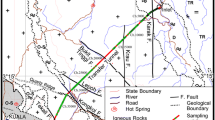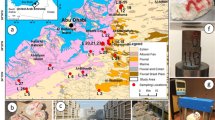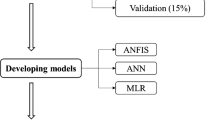Abstract
The strength of anisotropic rock masses can be evaluated through either theoretical or experimental methods. The latter is more precise but also more expensive and time-consuming especially due to difficulties of preparing high-quality samples. Numerical methods, such as finite element method (FEM), finite difference method (FDM), distinct element method (DEM), etc. have been regarded as precise and low-cost theoretical approaches in different fields of rock engineering. On the other hand, applicability of intelligent approaches such as fuzzy systems, neural networks and decision trees in rock mechanics problems has been recognized through numerous published papers. In current study, it is aimed to theoretically evaluate the strength of anisotropic rocks with through-going discontinuity using numerical and intelligent methods. In order to do this, first, strength data of such rocks are collected from the literature. Then FlAC, a commercially well-known software for FDM analysis, is applied to simulate the situation of triaxial test on anisotropic jointed specimens. Reliability of this simulation in predicting the strength of jointed specimens has been verified by previous researches. Therefore, the few gaps of the experimental data are filled by numerical simulation to prevent unexpected learning errors. Furthermore, a sensitivity analysis is carried out based on the numerical process applied herein. Finally, two intelligent methods namely feed forward neural network and a newly developed fuzzy modeling approach are utilized to predict the strength of above-mentioned specimens. Comparison of the results with experimental data demonstrates that the intelligent models result in desirable prediction accuracy.












Similar content being viewed by others
References
Asadi M, Bagheripour MH (2007) Modelling triaxial test on jointed rocks. Proc. 3rd Iranian Rock Mech Conf Amircabir University of Technology. Tehran, Iran (In Persian)
Asadi M, Eftekhari M, Bagheripour MH (2011) Evaluating the strength of intact rocks through genetic programming. Appl Soft Comput 11:1932–1937
Asadi M, Bagheripour MH, Eftekhari M (2013) Development of optimal fuzzy models predicting the strength of intact rocks. Comput Geosci 54:107–112
Attewell B, Sandford MR (1974) Intrinsic shear strength of a brittle anisotropic rock. I. Experimental and mechanical interpretation. II. Textural data acquisition and processing. III. Textural interpretation of failure. Int J Rock Mech Min Sci 11:423–430, 431–438, 439–451
Bagheripour MH, Mostyn GR (1996) Prediction of strength of jointed rock—theory and practice. Proc. ISRM Int Symp On Prediction and Performance in Rock Mechanics and Rock Engineering. EUROCK 96. Torino, Italy
Cevik A, Sezer EA, Cabalar AF, Gokceoglu C (2011) Modeling of the uniaxial compressive strength of some clay-bearing rocks using neural network. Appl Soft Comput 11:2587–2594
Donath FA (1964) A strength variation and deformational behavior of anisotropic rocks. In: State of stress in the Earth crust, pp. 281–97. Elsevier, New York
Gokceoglu C, Yesilnacar E, Sonmez H, Kayabasi A (2004) A neuro-fuzzy model for modulus of deformation of jointed rock masses. Comput Geotech 31:375–383
Goutte C (1997) Note on free lunches and cross-validation. Neural Comput 9:1211–1215
Hoek E, Carranza-Torres C, Corkum B (2002) Hoek-Brown failure criterion—2002 edition. Proc NARMS-TAC Conf Toronto 1:267–273
Horino FG, Ellickson ML (1970) A method for estimating strength of rock containing planes of weakness. USBM Rep Inv 7449:26
Jang J-SR (1993) ANFIS: adaptive network based fuzzy inference system. IEEE Trans Syst Man Cybernet 23(3):665–683
Kalantary F, Ardalan H, Nariman-Zadeh N (2009) An investigation on the Su–NSPT correlation using GMDH type neural networks and genetic algorithms. Eng Geol 104:144–155
Latha GM, Garaga A (2012) Elasto-plastic analysis of jointed rocks using discrete continuum and equivalent continuum approaches. Int J Rock Mech Min Sci 53:56–63
Liang YC, Feng DP, Liu GR, Yang XW, Han X (2003) Neural identification of rock parameters using fuzzy adaptive learning parameters. Comput Struct 81:2373–2382
McLamore R, Gray KE (1967) The mechanical behavior of anisotropic sedimentary rocks. J Eng For Industry, Trans Am Soc Mech Engrs, Ser B 80:62–73
Mishra DA, Basu A (2013) Estimation of uniaxial compressive strength of rock materials by index tests using regression analysis and fuzzy inference systems. Eng Geol 160:54–68
Niandou H, Shao JF, Henry JP, Fourmaintraux D (1997) Laboratory investigation of mechanical behavior of Tournemire shale. Int J Rock Mech Min Sci 34:3–16
Pietruszczak S, Mroz Z (2001) On failure criteria for anisotropic cohesive-frictional materials. Int J Numer Anal Methods Geomech 25:509–524
Ramamurthy T, Rao GV, Rao KS (1985) Strength criterion for rocks. Proc Indn Geotech Conf Roorkee 1:59–64
Ramamurthy T (1993) Strength and modulus responses of anisotropic rocks. In: Hudson JA (ed) Comprehensive rock engineering, vol. L. Fundamentals. Pergamon Press, Oxford, pp 313–329
Ramamurthy T, Arora VK (1994) Strength predictions for jointed rocks in confined and unconfined states. Int J Rock Mech Min Sci Geomech Abstr 31(1):9–22
Rao KS (1984) Strength and deformation behaviour of sandstones. Ph.D. Thesis, IIT Delhi, India
Schalkoff RJ (1997) Artificial neural networks. McGraw-Hill, New York
Sitharam TG, Sridevi J, Shimizu N (2001) Practical equivalent continuum characterization of jointed rock masses. Int J Rock Mech Min Sci 38:437–448
Tien YM, Tsao PF (2000) Preparation and mechanical properties of artificial transversely isotropic rock. Int J Rock Mech Min Sci 37:1001–1012
Tien YM, Kuo MC (2001) A failure criterion for transversely isotropic rocks. Int J Rock Mech Min Sci 38:399–412
Wen-Xiu L, Hai-Ning L (2009) Fuzzy system models (FSMs) for analysis of rock mass displacement caused by underground mining in soft rock strata. Expert Syst Appl 36:4637–4645
Author information
Authors and Affiliations
Corresponding author
Additional information
Communicated by: H. A. Babaie
Rights and permissions
About this article
Cite this article
Asadi, M., Bagheripour, M.H. Numerical and intelligent modeling of triaxial strength of anisotropic jointed rock specimens. Earth Sci Inform 7, 165–172 (2014). https://doi.org/10.1007/s12145-013-0137-z
Received:
Accepted:
Published:
Issue Date:
DOI: https://doi.org/10.1007/s12145-013-0137-z




